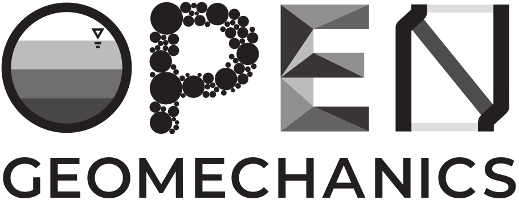A generic approach to encapsulating meso scale details and their associated dissipative mechanisms in constitutive models for geomaterials is presented. The focus is the explicit meso-macro link as the basis for developments of constitutive models. These links are usually missing in constitutive modelling of geomaterials, leading to incorrect description of post-localisation behaviour at the constitutive (material) level. In other words, the classical definition of material behaviour associated with a unit volume element, based on conditions of homogenous deformation, ceases to exist once localised failure occurs. Such localisation issues can and should also be dealt with at the constitutive level. The proposed generic thermodynamics-based formulation to integrate meso scale behaviour of localisation band in constitutive models provides a way to connect meso and macro scales so that post-localisation behaviour can be correctly described at the constitutive level. Examples on onset of localisation and post-localisation behaviour are used to demonstrate key features and benefits of the proposed approach.
Revised:
Accepted:
Published online:
 CC-BY-NC-SA 4.0
CC-BY-NC-SA 4.0
@article{OGEO_2022__3__A3_0,
author = {Nguyen, Giang Dinh and Mir, Arash and Bui, Ha Hong},
title = {Enriching constitutive models with meso-scale behaviour: a thermodynamics-based formulation and examples},
journal = {Open Geomechanics},
eid = {3},
pages = {1--19},
year = {2022},
publisher = {Alert Geomaterials},
volume = {3},
doi = {10.5802/ogeo.12},
language = {en},
url = {https://opengeomechanics.centre-mersenne.org/articles/10.5802/ogeo.12/}
}
TY - JOUR AU - Nguyen, Giang Dinh AU - Mir, Arash AU - Bui, Ha Hong TI - Enriching constitutive models with meso-scale behaviour: a thermodynamics-based formulation and examples JO - Open Geomechanics PY - 2022 SP - 1 EP - 19 VL - 3 PB - Alert Geomaterials UR - https://opengeomechanics.centre-mersenne.org/articles/10.5802/ogeo.12/ DO - 10.5802/ogeo.12 LA - en ID - OGEO_2022__3__A3_0 ER -
%0 Journal Article %A Nguyen, Giang Dinh %A Mir, Arash %A Bui, Ha Hong %T Enriching constitutive models with meso-scale behaviour: a thermodynamics-based formulation and examples %J Open Geomechanics %D 2022 %P 1-19 %V 3 %I Alert Geomaterials %U https://opengeomechanics.centre-mersenne.org/articles/10.5802/ogeo.12/ %R 10.5802/ogeo.12 %G en %F OGEO_2022__3__A3_0
Nguyen, Giang Dinh; Mir, Arash; Bui, Ha Hong. Enriching constitutive models with meso-scale behaviour: a thermodynamics-based formulation and examples. Open Geomechanics, Volume 3 (2022), article no. 3, 19 p.. doi: 10.5802/ogeo.12
[1] Spatial Variation of Void Ratio and Shear Band Thickness in Sand Using X-ray Computed Tomography, Géotechnique, Volume 58 (2008) no. 4, pp. 249-257
[2] Experimental Investigation of Microstructural Changes in Deforming Granular Media Using x-Ray Tomography, Ph. D. Thesis, Université de Grenoble (2013)
[3] Experimental Micro-Mechanics of Granular Media Studied by x-Ray Tomography: Recent Results and Challenges, Géotechnique Letters, Volume 3 (2013) no. 3, pp. 142-146
[4] Why Continuum Damage Is Nonlocal: Micromechanics Arguments, Journal of Engineering Mechanics, Volume 117 (1991) no. 5, pp. 1070-1087
[5] Compaction Localization in Porous Sandstones: Spatial Evolution of Damage and Acoustic Emission Activity, Journal of Structural Geology, Volume 26 (2004) no. 4, pp. 603-624
[6] Smoothed Particle Hydrodynamics (SPH) and Its Applications in Geomechanics: From Solid Fracture to Granular Behaviour and Multiphase Flows in Porous Media, Computers and Geotechnics, Volume 138 (2021), 104315
[7] A Finite Element Model for Strain Localization Analysis of Strongly Discontinuous Fields Based on Standard Galerkin Approximation, Computer Methods in Applied Mechanics and Engineering, Volume 190 (2000) no. 11–12, pp. 1529-1549
[8] Shear-Enhanced Compaction and Strain Localization: Inelastic Deformation and Constitutive Modeling of Four Porous Sandstones, Journal of Geophysical Research (Solid Earth), Volume 111 (2006), B12401
[9] Origin of Compaction Bands: Anti-cracking or Constitutive Instability?, Tectonophysics, Volume 499 (2011) no. 1, pp. 156-164
[10] Shear-Enhanced Compaction Band Identification at the Laboratory Scale Using Acoustic and Full-Field Methods, International Journal of Rock Mechanics and Mining Sciences, Volume 67 (2014), pp. 240-252
[11] Simulation of Soil-Concrete Interfaces with Nonlocal Constitutive Models, Journal of Engineering Mechanics, Volume 113 (1987) no. 11, pp. 1665-1677
[12] Gradient-Dependent Plasticity: Formulation and Algorithmic Aspects, International Journal for Numerical Methods in Engineering, Volume 35 (1992) no. 3, pp. 521-539
[13] Compaction Bands Due to Grain Crushing in Porous Rocks: A Theoretical Approach Based on Breakage Mechanics, Journal of Geophysical Research: Solid Earth, Volume 116 (2011), B08203
[14] The Propagation of Compaction Bands in Porous Rocks Based on Breakage Mechanics, Journal of Geophysical Research: Solid Earth, Volume 118 (2013), pp. 2049-2066
[15] A Thermomechanical Constitutive Model for Cemented Granular Materials with Quantifiable Internal Variables. Part II – Validation and Localization Analysis, Journal of the Mechanics and Physics of Solids, Volume 70 (2014), pp. 382-405
[18] A Thermomechanical Framework for Constitutive Models for Rate-Independent Dissipative Materials, International Journal of Plasticity, Volume 16 (2000) no. 9, pp. 117-1047
[19] Principles of Hyperplasticity - An Approach to Plasticity Theory Based on Thermodynamic Principles, Springer-Verlag, London, 2006
[20] Comparative Study on Finite Elements with Embedded Discontinuities, Computer Methods in Applied Mechanics and Engineering, Volume 188 (2000) no. 1, pp. 307-330
[21] Nonlocal Models for Damage and Fracture: Comparison of Approaches, International Journal of Solids and Structures, Volume 35 (1998) no. 31–32
[22] Damage Tensors and the Crack Density Distribution, International Journal of Solids and Structures, Volume 30 (1993) no. 20, pp. 2859-2877
[23] Modelling Jointed Rock Mass as a Continuum with an Embedded Cohesive-Frictional Model, Engineering Geology, Volume 228 (2017), pp. 107-120
[24] Localised Failure Mechanism as the Basis for Constitutive Modelling of Geomaterials, International Journal of Engineering Science, Volume 133 (2018), pp. 284-310
[25] Incorporation of Micro-Cracking and Fibre Bridging Mechanisms in Constitutive Modelling of Fibre Reinforced Concrete, Journal of the Mechanics and Physics of Solids, Volume 133 (2019), 103732
[26] , CIGOS 2019, Innovation for Sustainable Infrastructure (2020), pp. 311-316
[27] Localised failure of geomaterials: how to extract localisation band behaviour from macro test data, Géotechnique, Volume 72 (2022) no. 7, pp. 596-609 | DOI
[28] Embedded Localization Band in Undrained Soil Based on Regularized Strong Discontinuity–Theory and FE-analysis, International Journal of Solids and Structures, Volume 33 (1996) no. 20–22, pp. 3081-3101
[29] Compaction Bands: A Structural Analog for Anti-Mode I Cracks in Aeolian Sandstone, Tectonophysics, Volume 267 (1996) no. 1, pp. 209-228
[30] A Thermodynamic Approach to Modelling Brittle-Ductile and Localised Failure of Rocks Using Damage Mechanics and Plasticity Theory, Ph. D. Thesis, University of Adelaide (2017)
[31] A Thermodynamics-Based Model for Brittle to Ductile Behaviour and Localised Failure of Porous Rocks, International Journal of Solids and Structures, Volume 152 (2018), pp. 161-184
[32] The Thickness of Shear Bands in Granular Materials, Géotechnique, Volume 37 (1987) no. 3, pp. 271-283
[33] A Thermodynamics- and Mechanism-Based Framework for Constitutive Models with Evolving Thickness of Localisation Band, International Journal of Solids and Structures, Volume 187 (2020), pp. 100-120
[34] How to Connect Two Scales of Behaviour in Constitutive Modelling of Geomaterials, Géotechnique Letters, Volume 2 (2012) no. 3, pp. 129-134
[35] Non-Local Damage Modelling of Concrete: A Procedure for the Determination of Model Parameters, International Journal for Numerical and Analytical Methods in Geomechanics, Volume 31 (2007) no. 7, pp. 687-891
[36] A Constitutive Modelling Framework Featuring Two Scales of Behaviour: Fundamentals and Applications to Quasi-Brittle Failure, Engineering Fracture Mechanics, Volume 115 (2014), pp. 221-240
[37] Constitutive Modelling of Compaction Localisation in Porous Sandstones, International Journal of Rock Mechanics and Mining Sciences, Volume 83 (2016), pp. 57-72
[38] Constitutive Modelling of Progressive Localised Failure in Porous Sandstones Under Shearing at High Confining Pressures, International Journal of Rock Mechanics and Mining Sciences, Volume 93 (2017), pp. 179-195
[39] A Size-Dependent Constitutive Modelling Framework for Localised Failure Analysis, Computational Mechanics, Volume 58 (2016) no. 2, pp. 257-280
[40] Bifurcations in Elastic-Plastic Materials, International Journal of Solids and Structures, Volume 30 (1993) no. 4, pp. 521-544
[41] A Comparative Study on Finite Elements for Capturing Strong Discontinuities: E-FEM Vs X-FEM, Computer Methods in Applied Mechanics and Engineering, Volume 195 (2006) no. 37, pp. 4732-4752
[42] Modelling Strong Discontinuities in Solid Mechanics Via Strain Softening Constitutive Equations. Part 1: Fundamentals, International Journal for Numerical Methods in Engineering, Volume 39 (1996) no. 21, pp. 3575-3600
[43] Nonlocal Damage Theory, Journal of Engineering Mechanics, Volume 113 (1987) no. 10, pp. 1517-1533
[44] Fundamental problems in viscoplasticity, Advances in Applied Mechanics, Volume 9 (1966), pp. 243-377
[45] Modeling of Deformation and Localized Failure in Anisotropic Rocks, International Journal of Solids and Structures, Volume 67-68 (2015), pp. 93-101
[46] On Homogeneous and Localized Deformation in Water-Infiltrated Soils, International Journal of Damage Mechanics, Volume 8 (1999) no. 3, pp. 233-253
[47] On Failure Criteria for Anisotropic Cohesiveâfrictional Materials, International Journal for Numerical and Analytical Methods in Geomechanics, Volume 25 (2001) no. 5, pp. 509-524
[48] Finite Element Analysis of Deformation of Strain-Softening Materials, International Journal for Numerical Methods in Engineering, Volume 17 (1981) no. 3, pp. 327-334
[49] Analysis of Transition from Diffuse to Localized Failure in Sandstone and Concrete Using Digital Image Correlation, Engineering Fracture Mechanics, Volume 267 (2022)
[50] Brittle Response of Concrete as a Localization Problem, International Journal of Solids and Structures, Volume 32 (1995) no. 11, pp. 1517-1533
[51] Conditions for the Localization of Deformation in Pressure-Sensitive Dilatant Materials, Journal of the Mechanics and Physics of Solids, Volume 23 (1975) no. 6, pp. 371-394
[52] A Note on Some Features of the Theory of Localization of Deformation, International Journal of Solids and Structures, Volume 16 (1980) no. 7, pp. 597-605
[53] Effect of Grain Size Distribution on the Shear Band Thickness Evolution in Sand, Géotechnique, Volume 72 (2022) no. 4
[54] Continuum–Discontinuum Modelling of Shear Bands, International Journal for Numerical Methods in Engineering, Volume 62 (2005) no. 13, pp. 1857-1872
[55] Frictional Slip Plane Growth by Localization Detection and the Extended Finite Element Method (XFEM), International Journal for Numerical and Analytical Methods in Geomechanics, Volume 35 (2011) no. 11, pp. 1278-1298
[56] Anticrack Inclusion Model for Compaction Bands in Sandstone, Journal of Geophysical Research: Solid Earth, Volume 110 (2005) no. B11
[57] Shear Bands in Undrained Plane Strain Compression of Norwegian Quick Clays, Canadian Geotechnical Journal, Volume 55 (2017) no. 1, pp. 45-56
[58] Micromechanically Inspired Investigation of Cemented Granular Materials: Part II– from Experiments to Modelling and Back, Acta Geotechnica (2022) | DOI
[59] Modelling 3D Desiccation Cracking in Clayey Soils Using a Size-Dependent SPH Computational Approach, Computers and Geotechnics, Volume 116 (2019), 103209
[60] Shear-Banding and Liquefaction in Granular Materials on the Basis of a Cosserat Continuum Theory, Ingenieur-Archiv, Volume 59 (1989) no. 2, pp. 106-113
[61] Formation of Shear Bands in Sand Bodies as a Bifurcation Problem, International Journal for Numerical and Analytical Methods in Geomechanics, Volume 2 (1978) no. 2, pp. 99-128
[62] , Proceedings of the 8th International Conference on Fracture, Fatigue and Wear (2021), pp. 397-405
[63] Bifurcation Analysis in Geomechanics, Blackie Academic and Professional, 1995
[64] A New SPH-based Continuum Framework with an Embedded Fracture Process Zone for Modelling Rock Fracture, International Journal of Solids and Structures, Volume 159 (2019), pp. 40-57
[65] A New Method for Modelling Cohesive Cracks Using Finite Elements, International Journal for Numerical Methods in Engineering, Volume 50 (2001) no. 12, pp. 2667-2682
[66] Simulation of Mixed-Mode Fracture Using SPH Particles with an Embedded Fracture Process Zone, International Journal for Numerical and Analytical Methods in Geomechanics, Volume 44 (2020) no. 10, pp. 1417-1445
[67] Numerical Analysis of Concrete Fracture Based on a Homogenization Technique, Computers & Structures, Volume 63 (1997) no. 3, pp. 497-509
[68] An Introduction to Thermomechanics (2nd Ed.), North Holland, Amsterdam, 1983
Cited by Sources:





